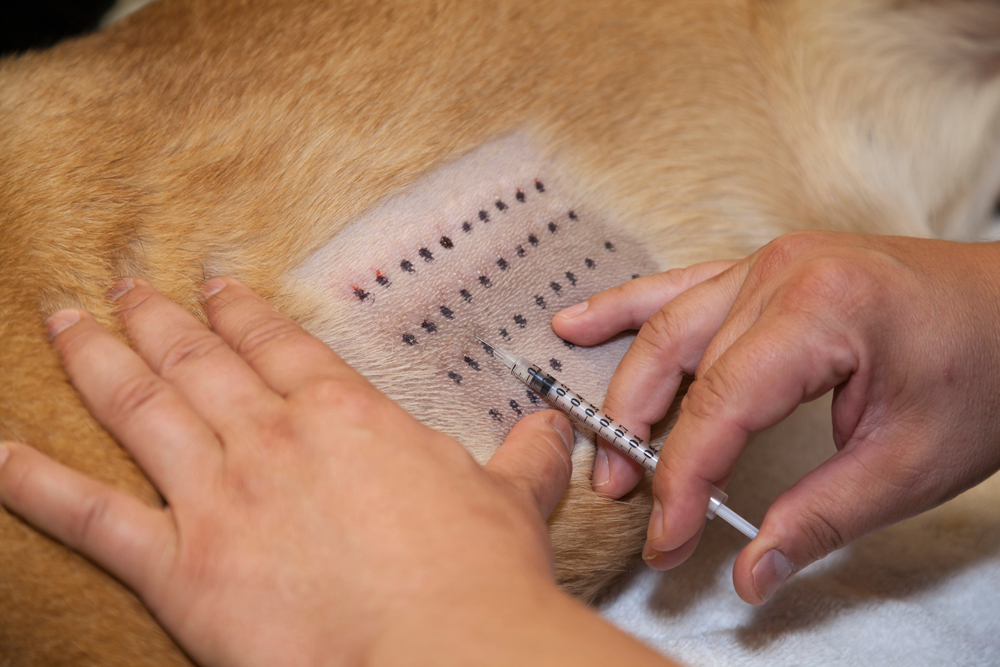Itchy skin or ears due to allergies are common problems for many dogs—around 30% of dogs will develop allergies at some point—but parasites, skin infections, and other systemic and dermatologic conditions also make pets itchy. Relieving your pet’s itch depends on accurate diagnosis of the underlying cause, which often requires your veterinarian to take multiple steps.
Our Animal Care & Emergency Services team can help if your pet becomes acutely or severely itchy, but most pets with itchy skin should first see their primary veterinarian. We outline the diagnostic steps your primary veterinarian will likely take to reach a diagnosis, but note that the order and number of steps will depend on your pet, their test results, and their treatment response.
#1: A complete physical examination of your pet
A physical examination is the foundation for any pet diagnosis, including skin disease. Your veterinarian will closely examine your pet’s skin and ears, paying close attention to red, itchy, darkened, rashy, or thinly haired areas, and check the rest of the body to find clues that would relate the skin problem to an underlying systemic disease. Your veterinarian will likely order blood and urine tests if they suspect systemic disease.
A pet’s skin lesion type and pattern can help your veterinarian narrow down possible causes. For example, pets with itchy, hairless feet likely have environmental or food allergies, while pets with hair loss around their tail base may have flea allergies.
#2: Pet skin diagnostics
Skin diagnostic tests, which are performed during your pet’s initial outpatient visit, help your veterinary team rule out or diagnose parasite infestations and bacterial or fungal skin infections. The “big three” skin tests the team may perform during your visit include:
- Skin scraping — This test is used when mange mites, including sarcoptic mange are suspected. Deep skin cells and hair follicle contents are collected and examined under a microscope.
- Skin cytology — A cytology test looks at skin cells that are collected via tape or an impression smear to look for bacteria, yeast, or white blood cells that may indicate a skin infection.
- Dermatophyte culture — Plucked hairs near skin lesion edges are placed in special media to see if ringworm-causing dermatophytes are present.
If these tests reveal a mange mite or dermatophyte infection, no further testing is required, and your veterinarian will treat the condition. If a bacterial or yeast skin infection is present, your veterinarian will treat the infection, but may order additional tests to find the underlying cause, which is typically an allergy or endocrine disorder.
Pets who do not respond appropriately to therapy for their suspected itch cause may need a bacterial skin culture or skin biopsy to investigate the possibility of less common causes, such as autoimmune disease or cancer.
#3: Parasite prevention trial to rule out a flea allergy
Flea allergy is a common reason for pet itching, but diagnosis is not as straightforward as simply identifying fleas. Some pets may not have an active infestation, but will severely react to only one or two flea bites, while others with many fleas appear fine. To rule out flea allergy as a possible itch cause, your veterinarian will recommend a parasite preventive that you must administer year-round to eliminate fleas from your pet and home.
#4: Food trial to rule out a pet food allergy
Environmental and food allergies in pets have similar signs, including itchy, red, irritated skin, chronic skin infections, and chronic ear infections. Your veterinarian can treat environmental allergies using appropriate medications, but should your pet’s signs not resolve entirely, they may recommend a food trial to determine whether the actual cause is a food allergy, or your pet has both allergies. A food trial involves feeding your pet a hydrolyzed or novel protein diet for at least two to three months, with no outside treats, flavored medications, or table scraps. If pets improve on this diet, your veterinarian may recommend adding individual ingredients back in one at a time to find the problem food.
#5: Skin or blood pet allergy testing

Pets with severe environmental allergies or who do not respond well enough to standard therapies may benefit from allergy testing and immunotherapy. Immunotherapy is a customized protocol administered orally or by injection that desensitizes your pet to their specific allergy triggers, works in about two-thirds of allergic pets, and may take up to a year to take full effect. Your primary veterinarian or a dermatology specialist can perform this testing.
Your primary veterinarian is your best resource to diagnose and treat your pet’s itchy, red, or irritated skin, but our team is available 24/7 for skin emergencies. If your pet develops an urgent or emergency skin problem, such as a severe hot spot, hives, facial swelling, severe, uncontrollable itching, a broken nail, or a skin wound, contact us right away, or visit our Animal Care & Emergency Services team.







Leave A Comment